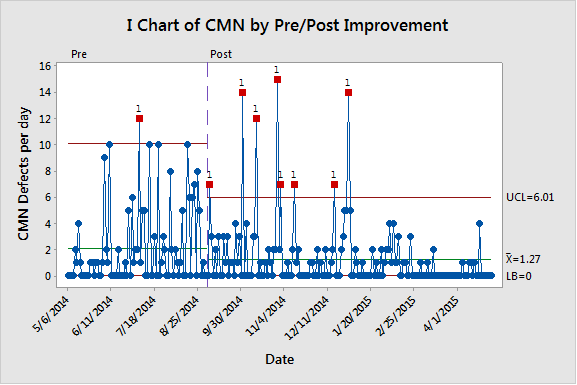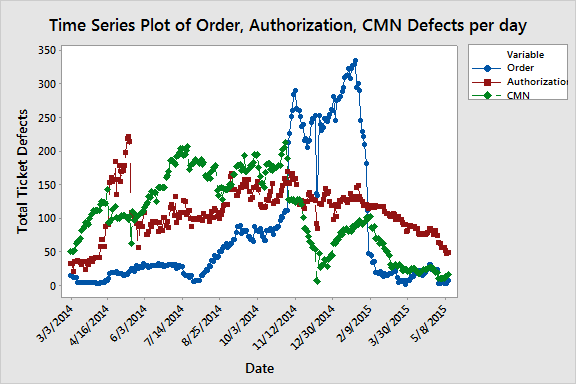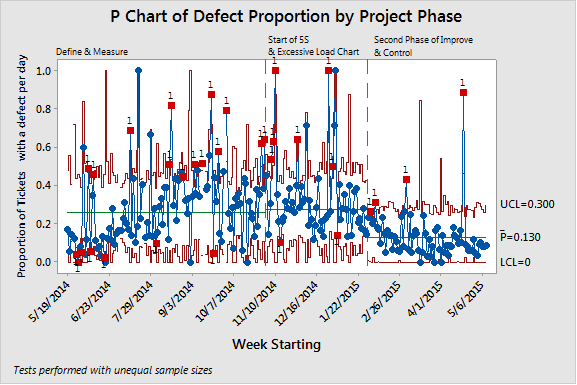Any serious medical condition brings challenges, but unexpected emotional and financial hardships encountered by both patients and their families often bring additional complications. That’s why Akron Children’s Hospital—the largest pediatric healthcare system in northern Ohio—started Children’s Home Care Group, a service that provides children who have certain conditions with quality healthcare in the comfort of their own homes. The program also eases financial burdens by helping families avoid long-term hospital stays. But problems with Home Care’s billing process resulted in increased time to bill and unnecessary write-offs. So a Lean Six Sigma project team trained by the hospital’s Mark A. Watson Center for Operational Excellence (COE) set out to address the problems and optimize the billing process. They identified causes of billing defects using Minitab Statistical Software and ultimately decreased the average number of days from product delivery to billing by 90%.
The Challenge
Along with in-home care, Akron Children’s offers infusion services, which provide medical supplies, diapers, medications, and formula to both homebound and ambulatory patients. Families acknowledge receipt of the delivered items by signing a ticket, which Home Care forwards to another Akron Children’s Hospital department, Healthcare Business Solutions (HBS), for processing.

A project team at Akron Children’s Hospital used Minitab Statistical Software to analyze data, resulting in newly implemented processes that decreased the time to bill patients and reduced defects. The hospital’s Cedar-Pine building, above, houses the Center for Operations Excellence, as well as Home Care and HBS.
Three processed documents are required in order to successfully bill a ticket: a Certificate of Medical Necessity (CMN) for Medicaid patients, which proves that services are essential; an authorization from the insurance company, which ensures the patient’s insurance plan will cover medical costs; and an order, or acknowledgment of receipt of prescription, which allows the prescription to be filled.
Akron Children’s Hospital cannot bill the patient without all three documents, which results in reduced and delayed revenue. The hospital had to write off those losses, and staff had to spend time resolving these issues instead of performing more valuable tasks. And with a ticket defect rate of 30 percent, the situation was quickly becoming critical.
The project team needed to examine the billing process and investigate the potential causes of defective tickets. The team sought to standardize the ticket process and reduce the defect rate to 16%. But to accomplish this, they needed to bridge the communication gap between Home Care and HBS—and improve the processes of two different departments—using data analysis.
How Minitab Helped
The team began by selecting 30 random CMNs and identifying their defects. They determined that many ticket defects were related to problems with the CMNs—60% of these tickets had expired, and the remaining tickets were never received, had been filled out incorrectly, or were written for the wrong or outdated products.

Home Care department employees at Akron Children’s Hospital use monthly reports to sustain improvements to the billing process. Data analysis with Minitab Statistical Software decreased billing time by 90% and reduced defects to 13.3%.
The team devised and implemented an improved process to correct the CMN-related issues, educated employees on the new process, and created Standard Work Instructions (SWI) for providers to properly complete a CMN. They tracked the pre- and post-improvement CMN process by plotting counts of defective CMNs on a Minitab individuals chart.

The I chart above plots the number of defective CMNs over a period of time and focuses on comparing the pre- and post-improvement process. The chart shows a decrease in the average number of CMN defects after changes were implemented.
The chart helped the team visualize the post-improvement drop in the average number of CMN defects. Their success with the CMN improvements led the team to evaluate all possible contributors to defective tickets using a time series plot, which helped to identify patterns in the data.
“We had thought the CMNs were the root cause of ticket defects,” says Jennifer Henley, Green Belt and Office Coordinator for the COE. “But when we looked at our data in the time series plot, we quickly realized other issues needed to be fixed, too—it was the turning point for the whole project.”

The time series plot above displays the total outstanding tickets in billing review separated into groups: Order, Authorization, and CMN. It shows that while the CMN process was improving, the number of outstanding tickets began to rise during the same time period.
The time series plot tracked the total outstanding tickets in billing review due to incomplete CMNs, authorizations, and orders. Although improvements to the process helped reduce CMN defects, the number of order-related defects began to increase, as seen by the spike in total ticket defects for orders on the time series plot.
After their analysis revealed the issue, an investigation helped the team understand the relationship between the two groups. “We realized that the orders needed to be matched to the CMNs in the computer system,” Henley explains. “But the orders weren’t being placed where HBS employees could find them, and therefore weren’t electronically entered along with the appropriate records.”
The discovery that the tickets could not be billed because they had not been updated in the system shifted the team’s efforts during the second phase of process changes, which focused on simplifying order entry into the computer system. The team narrowed the options on the status code list for CMNs, created standard work instructions on how to run the billing review reports, and designated an employee who would be responsible for following up on outstanding CMNs.

The control chart above displays the proportion of defective tickets, which saw a statistically significant reduction after changes to the order process.
A control chart helped the team examine the proportion of defective tickets, which decreased after the order process was improved. Evaluating that the reduction in defect rate was statistically significant, the team was able to confirm the success of these changes to the billing process.
Results
Streamlining the two organization’s processes ultimately lowered the defect rate to 13.3%—exceeding the team’s original project goal of 16%. Even more important, improving the billing process eliminated time spent correcting ticket defects, which decreased the average number of days from product delivery to billing by 90%.
“The most satisfying part of the project was using Minitab to tell a story,” says Henley, a first-time Minitab user. “It was easy to navigate and find what I needed—it allowed me to help the department, and ultimately, the patients and families, too.”
Improvements are being sustained. Monthly reports are being run, which help employees monitor process metrics, such as accruals, time from delivery to billing, and the time from confirmation to billing.
“We wouldn’t have come this far without understanding the data,” reports Henley. “Once I started using Minitab, I could provide visuals that helped both departments understand where the problems were—and that a solution wasn’t as difficult as they had thought.”

Organization
Akron Children’s Hospital
Overview
- Largest pediatric healthcare system in northern Ohio
- Operates 2 pediatric hospitals, 26 pediatrician offices, and more than 60specialty locations across the region
- Performed nearly 850,000 patient visits in 2014
- Patients include infants, children, teens, burn victims of all ages and adults with congenital, genetic and maternal/fetal conditions
- Began as a day nursery in 1890
Challenge
Streamline billing process in order to provide better care and reduce defects.
Products Used
Minitab® Statistical Software
Results
- Decreased number of days from delivery to billing by 90%
- Reduced defects to 13.3%



